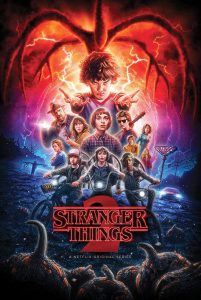
Today I’m ripping an issue from the headlines and tying the implications to your current content marketing strategy. Whether you’re a big brand or a solopreneur trying to stand out with a blog or YouTube channel, pay attention. We’re about to have an important lesson about the content marketing arms race served to us by our friends at Netflix …
The juggernaut
 Netflix seemed unstoppable. The company raced from mail delivery of movies into the streaming movie space leaving Blockbuster in its dust. At the height of its popularity, Netflix was attracting 2.5 million new users per month.
Netflix seemed unstoppable. The company raced from mail delivery of movies into the streaming movie space leaving Blockbuster in its dust. At the height of its popularity, Netflix was attracting 2.5 million new users per month.
To secure its place as the premier streaming service, Netflix started producing its own TV shows and movies. While this is common now, at the time this was revolutionary. Netflix was going to compete with the big TV and movie studios? Crazy.
But they did it, pumping out mega-hits such as Stranger Things, Ozark, and The Crown. The company had 105 Emmy nominations this year as well as dozens of Oscar nominations, including one for Best Picture.
If we looked at this from a content marketing playbook, they were doing everything right. And yet the company is in deep trouble. They are losing subscribers, cutting costs, and streamlining their movie offerings.
The company is in a meltdown. Netflix has seen 970,000 subscribers cancel in the last three months – the first time the company had ever experienced consecutive months of subscription losses. They’re not the only ones to have issues. Even Disney+ has met challenges keeping subscribers. After the release of Hamilton in July 2020, they drew in new customers, only for 30% of them to unsubscribe just a month later!
And this is something I predicted in 2014 …
The content marketing arms race
Early in that year, I wrote about an idea I called Content Shock. The main element of this idea:
As content niches reach saturation, it becomes more difficult to compete. As competitors enter the field, you’re trapped in a never-ending arms race as companies spend more to produce and promote their content. The companies with the deepest pockets will win. Smaller businesses will drop out because it becomes too expensive. In that event, content marketing is not a sustainable strategy.
I also wrote that this pattern repeats itself in every content channel. At first, it’s easy to earn engagement and views, but that diminishes over time as saturation increases.
What does this have to do with Netflix and you?
Here is a chart recently posted by James McMahon that paints a fascinating portrait of the Netflix content marketing arms race. It’s a little busy, so let me interpret it for you. This chart shows the number of weeks a popular show will remain in the Top 10 of all Netflix shows.
In the early days (2000-2005) about 10 percent of the shows hung around for 40 weeks or more.
Today, movies and TV shows drop off the Top 10 list almost right away. It’s unusual for the best shows to stay at the top of the charts for even five weeks!

What’s happening here?
 This is what I predicted about the company four years ago at the height of its popularity:
This is what I predicted about the company four years ago at the height of its popularity:
An all-out content arms race began on February 01, 2013.
That was the day Netflix launched a bold new series called House of Cards. It was a big-budget risk that put the story and the writing front and center. Netflix had one goal — create a serialized show that was so un-missable that people would have to subscribe to the streaming service.
The channel was transforming from a curator of content to a creator of content with its first original series.
It worked — Netflix attracted more than a million new subscribers. And it also began a content arms race that changed the industry … and may destroy the company.
My prediction is coming true. It’s Content Shock in action.
The glue that holds this whole industry together is the content. Not enjoying content is the biggest factors driving cancellations. Over a quarter of the viewers in the US believe that most shows on streaming services aren’t worth watching, with just over 1 in 5 of these consumers saying they mostly watch TV on services like Netflix and Hulu. So there’s a big customer base, but many are left feeling unsatisfied.
The deepest pockets win

As Netflix ramped up the content engine in 2013, so did its competitors and the arms race began. To the viewer’s delight, TV shows became movie-quality as the content creation budgets exploded.
HBO spent an average of $10 million per episode on the original series Game of Thrones. A year later, Disney spent a staggering $15 million per episode on The Mandalorian.
This was quickly eclipsed. Wanda Vision cost $28 million per episode and The Rings of Power averaged $35 million one year later. A content arms race.
Look who’s creating original television content: Amazon, Apple, Disney. These companies have very deep pockets. Can Netflix win? No. At least not in its current form and marketshare.
We see in this chart that Netflix is pushing out hit after hit — so many that the shows are falling off the Top 10 chart in a few weeks. Last week the BBC reported:
After enjoying a long reign as the king of streaming, Netflix faces a tough fight to keep its crown.
It lost almost a million subscribers between April and July as more people decided to quit the service.
Guy Bisson, executive director at Ampere Analysis, said it was “inevitable” that Netflix would start to see its grip on the market loosen.
“When you’re the leader, there’s only one direction to go, especially when a large amount of competition launches, which is what Netflix has seen in the last couple of years,” he said.
It is a stark change for Netflix, which enjoyed years of seemingly unstoppable growth, as it revolutionized the way people around the world consumed entertainment.
What does this mean for you?
Here are a few lessons from the Netflix Content Shock scenario. Look at how the major players are positioned to compete in this streaming arms race:
1. Are you “Amazon?”
The biggest problem in content marketing today is that most companies are pumping out content because they’re afraid not to. They don’t have a sense of their place in the industry or a strategic view of how it’s working for them. So they are creating random acts of content.
Lesson number one is, assess your competitive position. Is your industry saturated with content? How can you maneuver in that environment? Are you the market leader? A disruptor? What are your chances of realizing any benefit from your content marketing?
If you’re the market leader with the deepest pockets — like Amazon or Apple — you’re in a good position to win the content marketing arms race.
2. Are you “Disney?”
 The fastest-growing company on the streaming scene is Disney+. At least in one respect, it doesn’t matter what their competitors do because if you enjoy Marvel, Disney, or Star Wars products, you MUST go to Disney+ to see them. They own a unique content niche.
The fastest-growing company on the streaming scene is Disney+. At least in one respect, it doesn’t matter what their competitors do because if you enjoy Marvel, Disney, or Star Wars products, you MUST go to Disney+ to see them. They own a unique content niche.
There is a lesson here even for the smallest entrepreneurs. I have a small company. I will never win the SEO war on terms like “keynote speaker” or “digital marketing consultant.” But if you want access to my unique voice and content, you must subscribe to my blog and podcast.
Like Disney, I can have a sizable audience because of my unique properties, as long as I continue to maintain the advantage.
If you have a distinctive voice and authority to your content, you’re positioned to compete in the content marketing arms race. This is where I hope to compete. I’m not the biggest content producer, but i have a unique perspective you can only find on this blog.
3. Are you “Netflix?”
Content marketing is a mature tactic. Lots of companies are doing it. Many niches are filling up with great content, flipping Content Shock into action and initiating that content arms race.
 When Netflix fired the first shot across the bow with House of Cards, they hoped to carve out a niche of high-quality, original programming. And they did … for a while. But the big guns at Amazon and Disney started firing back by dramatically increasing their content budget, and Netflix became vulnerable.
When Netflix fired the first shot across the bow with House of Cards, they hoped to carve out a niche of high-quality, original programming. And they did … for a while. But the big guns at Amazon and Disney started firing back by dramatically increasing their content budget, and Netflix became vulnerable.
If you started on your content marketing path five years ago, is it still relevant and effective? How is Content Shock creeping in?
Netflix isn’t standing still. They see the writing on the wall and are exploring new options like doubling down on their most popular content (Like Stranger Things) and developing an ad revenue strategy that could lower subscription prices and bring in more revenue.
Netflix does not have the deep pockets to compete with Amazon, Apple, and Disney long-term. If you’re in the same boat — a content producer in a crowded niche — these might be relevant to you, too.
- Netflix is exploring new revenue streams like paid advertising. Are there ways you could leverage your existing content into other revenue models like online courses or books?
- Netflix has a portfolio of exciting original content. If they can’t turn their ship around, this asset would be very attractive to a company like Amazon or Apple. They could consider being acquired by a larger competitor. I think this is the most likely scenario for the company.
- The company could create just enough original buzz-worthy content to at least stay in the game. Think about the impact of sensations like Breaking Bad or Yellowstone. These shows became cultural icons. It might be possible to at least not lose share if they can keep coming up with truly important programming. In your world, this might mean publishing something epic at least every few months to hold the subscribers that you have.
These are the obvious strategies, and I’ll add two more that are also possible:
- Could you/Netflix create an exclusive experience for subscribers? What if they created a Stranger Things Experience through the Meta app store that was only available to subscribers?
- Could you create online/offline fan communities around certain shows that are only open to subscribers?
Anyway, I hope this gets you thinking in a new way. I haven’t explored this Content Shock topic in a long time, but it is more relevant than ever. In fact, if you’re working in the field of content marketing, it is the most important consideration in your strategy.
 Mark Schaefer is the executive director of Schaefer Marketing Solutions. He is the author of some of the world’s bestselling digital marketing books and is an acclaimed keynote speaker, college educator, and business consultant. The Marketing Companion podcast is among the top business podcasts in the world. Contact Mark to have him speak to your company event or conference soon.
Mark Schaefer is the executive director of Schaefer Marketing Solutions. He is the author of some of the world’s bestselling digital marketing books and is an acclaimed keynote speaker, college educator, and business consultant. The Marketing Companion podcast is among the top business podcasts in the world. Contact Mark to have him speak to your company event or conference soon.
Follow Mark on Twitter, LinkedIn, YouTube, and Instagram. Discover his $RISE creator community.
Netflix image courtesy Unsplash.com


